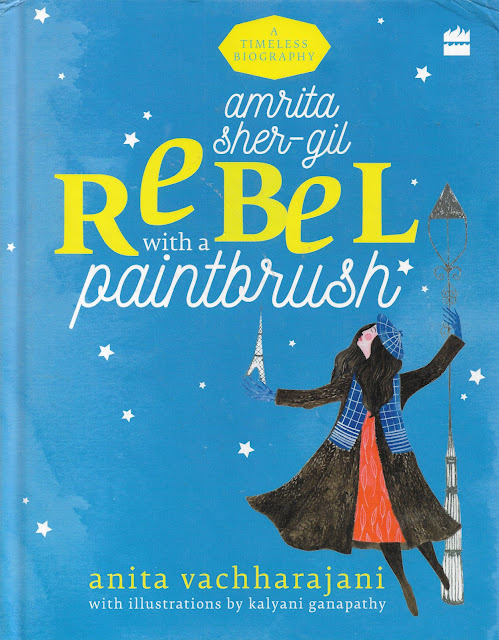Rebel with a paintbrush
Amrita Sher-gil
Rebel with a paintbrush
Anita Vachharajani
(With illustrations by Kalyani Ganpathy)
Number of pages: 182
First published: 2018
Publishers: HarperCollins
P-ISBN: 978-93-5277-473-9
Amrita
Some time ago a friend talked of how the mahaul one grows up amidst has an everlasting impact on our lives. We discussed Shabana Azmi – how the scholars she would have interacted with and the poetry she would have heard during her childhood (and youth) would have been an initiation with few parallels to learning language and a lot more. Similarly, Indira Gandhi - the museum at Allahabad shows her with Mohandas Gandhi in one image, with Rabindranath Tagore in another and so on during his childhood (and youth); add to this her being so widely travelled during those. Amrita appears to have a childhood on similar lines. A childhood which shaped her life.
Her father counted Muhammed Iqbal, the poet, amongst his friends. Photography was a hobby and he bought a camera during the 1890’s. Her uncle was a polymath – explorer, soldier, painter, traveller, Indologist, writer, translator. Amrita drew from a very young age. She also wrote. Parents took an 8-year Amrita to see Mona Lisa by Leonardo da Vinci when they were at Paris. At 13 she painted, acted, learnt music & dance, read, went on long walks – all this after moving out of the school that tried to force her to attend mass. The book mentions that Amrita’s parents must have been particularly unusual and modern for their times. And, of course, the family (Hungarian mother, Indian Sikh father) travelled and shifted bases across continents!
The story
The book can broadly be divided into 2 parts. Her growing up years – all that influenced her then. And Amrita the painter, an artists’ journey.
As I read and reread this book, I realized that making connections (with other artists, world events taking shape then and so on ~) within the flow makes so much more sense than talking about an artist in isolation. Art, like a lot else in our lives, thrives on these influences. This set of references helps one to understand Amrita and her world better.
The artists’ journey is captured with colours – those in the palettes and in her life. Including loves of her life. Love here is mentioned as a matter of fact. The book has a generous dose of her paintings as well. These appear in the book at the age she drew them at. It also showcases some of her photographs. These bring out her famed beauty.
The book
The book begins with ‘how to read this book’. This section is succinct and helps. Also, each chapter has a timeline at the beginning. Overall, the level of detailing is high and uncommon.
The high production quality ensures that the paintings have come out well. A book about a painter brings with it additional challenges of formatting, colouring and illustration. This is where the book scores high. The book is colourful but the colours do not hurt. Language is tight; does not try to impress.
Additional information ensures one does not jump to the web while reading. This information includes clarification of terms and depiction of works of other artists (Rabindranath Tagore, Raja Ravi Varma). In this sense the book is like a sumptuous meal. Besides, of course, being sensuous and tasty.
This is a book you are keen continues, slowly. A book where (like with some movies as well) most all aspects appear to fall nicely in place. A book where you revisit pages. This is a book which respects the intelligence of the readers. One which the adults will enjoy as much as the children, if not more.
At the end it is Amrita who overpowers you and not the book. For a society like ours to laud her talent and keep her memory alive she ought to have been special indeed.
Her life, ended before she was 30, reminded me of the line from the movie Anand – Zindagi badi honi chahiye, lambi nahin.
Thanks are due to Rakeshbhai at Harmony for making me aware to books such as this!


Interesting read.
ReplyDeletethanks ~
Delete